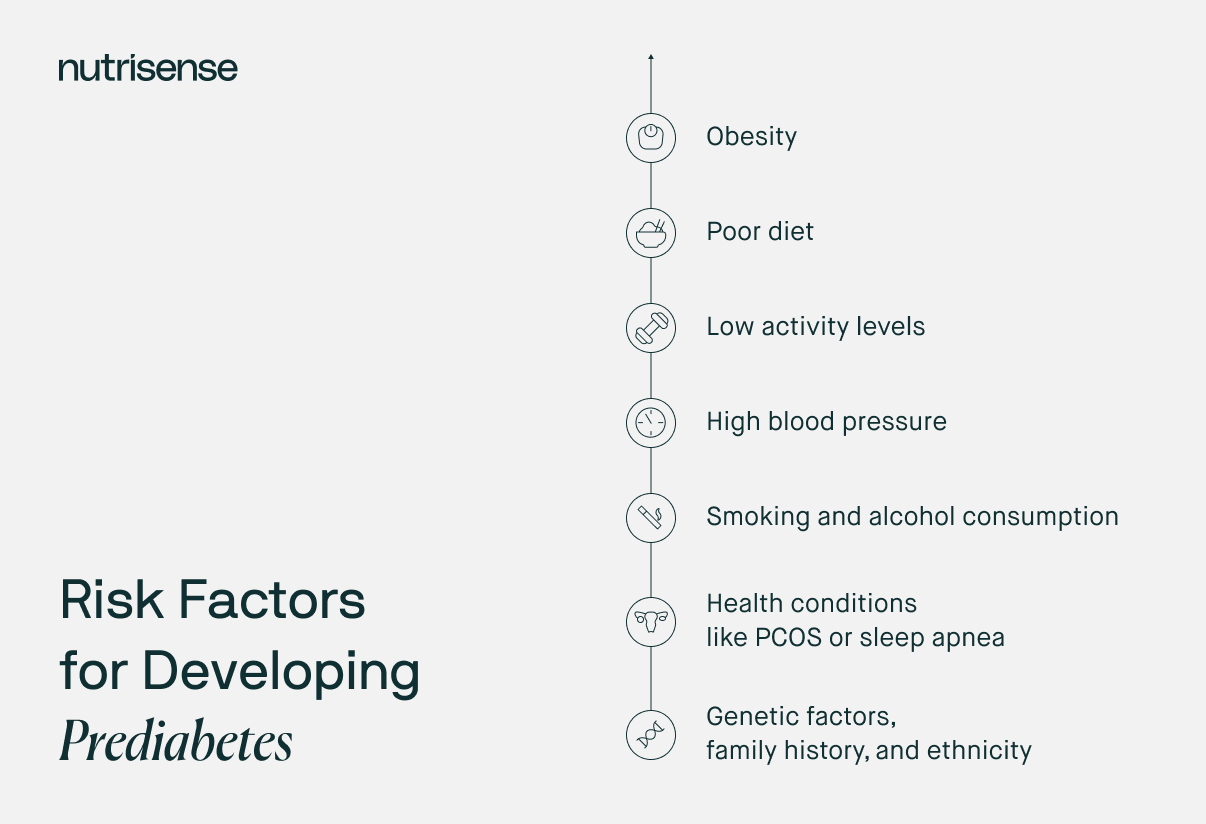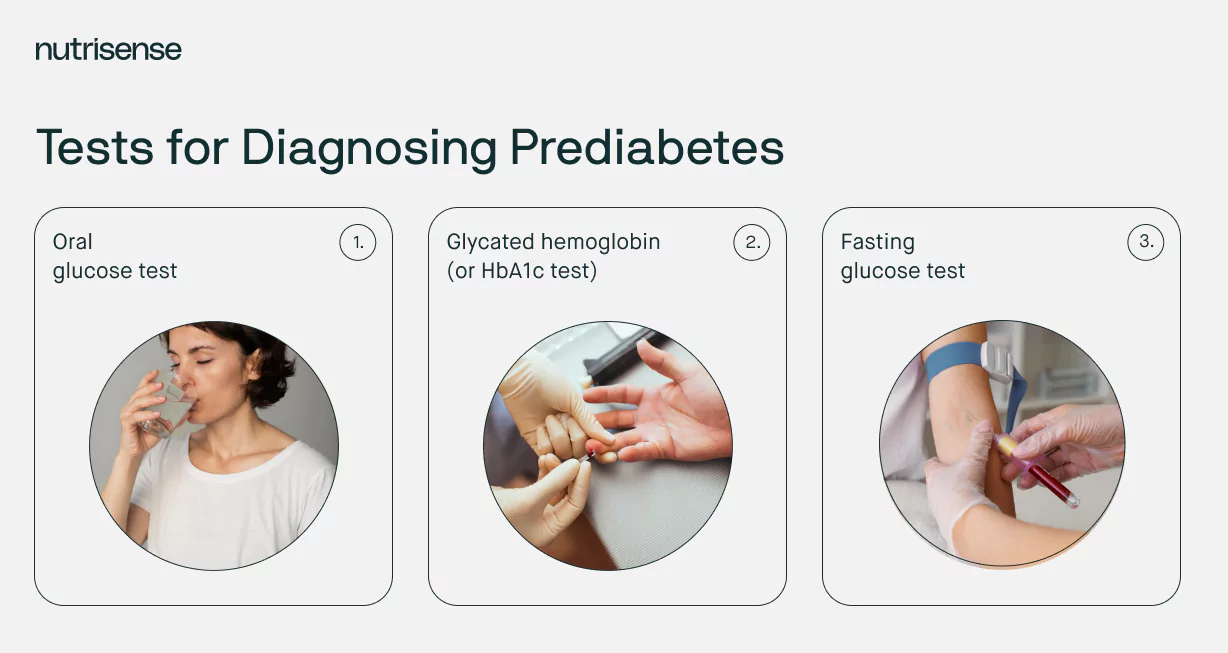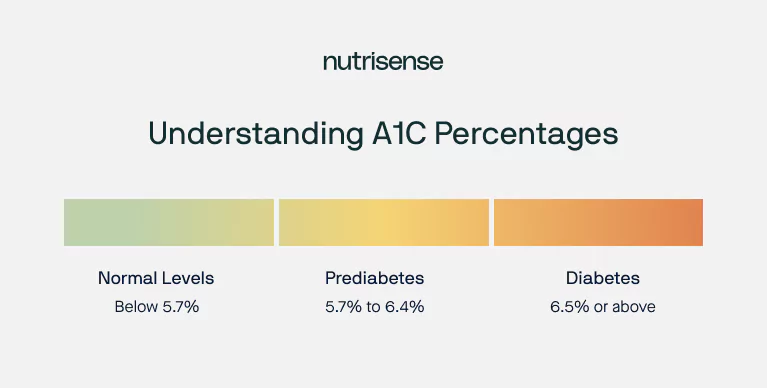The 8 Warning Signs of Prediabetes

Key Takeways
Diabetes is a major health issue in the United States. A total of 38.7 million people in America have diabetes, which is about 11 percent of the population.
And perhaps even more concerning—It’s estimated that 8.5 million of those people are undiagnosed.
Prediabetes is a condition that can eventually lead to diabetes, and affects an even greater number of people: around 96 million people aged 18 or older have prediabetes. That’s 38 percent of the population!
Prediabetes may not always come with specific symptoms for everyone. Read on to learn about some of the potential warning signs of prediabetes and diabetes.
What is Prediabetes?
Prediabetes means that your blood sugar is higher than normal, but not yet high enough to be considered type 2 diabetes. This condition can also be called impaired fasting glucose or impaired glucose tolerance.
Prediabetes can increase your risk of heart disease and damage blood vessels over time. If left untreated, it can lead to conditions like type 2 diabetes, high blood pressure, obesity, high cholesterol, and kidney disease.
The good news is that progression from prediabetes to diabetes is not necessarily inevitable. It is possible to reverse prediabetes.
Certain healthy lifestyle changes, like eating a healthy, balanced diet, appropriate physical activity, and maintaining a healthy weight can help support balanced glucose levels. Non-diabetic glucose monitoring using a CGM can also be helpful if you are looking to make healthier lifestyle choices that can support your overall health.
Some of the things that can put you at a higher risk of developing prediabetes include:

- Low activity levels: Especially following a sedentary lifestyle
- Certain health conditions: Polycystic ovary syndrome (PCOS) or obstructive sleep apnea
- Ethnicity: Pacific Islanders and people of black, Native American, Asian, or descent may be more at risk
Prediabetes Symtoms and Warning Signs
For many people, prediabetes symptoms may not be noticeable. Many potential symptoms of prediabetes are subtle, which is why it's important to be aware of what they are. Along with these symptoms, there are a few warning signs to watch out for that can indicate that prediabetes has progressed to type 2 diabetes.
The absence of these signs does not mean that you don’t have prediabetes or high blood sugar, and only your doctor can rule out or diagnose prediabetes or diabetes. If you are concerned about your blood sugar, visit your doctor.
Here are the top 8 potential symptoms of prediabetes to be aware of:
1) Increased Appetite and Hunger

An increased appetite, also called hyperphagia or polyphagia, can be a sign of chronically high blood sugar. It is also one of the main signs of type 2 diabetes.
When your blood sugar remains abnormally high, such as in uncontrolled diabetes where insulin receptors may not be working optimally, glucose cannot enter your cells and be used as energy. This lack of energy can cause an increase in hunger.
2) Dry Mouth
Dry mouth is a common symptom of high blood sugar, and is often the first noticeable symptom of diabetes. Dry mouth may happen to everyone occasionally, and it may not sound that serious.
But chronic dry mouth can cause bad breath, cracked or chapped lips, loose teeth, mouth sores, pain in the mouth or throat, and trouble chewing, swallowing, or talking. If you experience dry mouth, talk to your doctor.
3) Mood Swings

Unstable blood sugar and hyperglycemia are associated with an increased risk of depression, anxiety, anger, and mood swings. According to one study, elevated symptoms of anxiety may affect as much as 40 percent of people with diabetes.
4) Frequent Urination
Frequent urination, also called polyuria, can be caused by high blood sugar and is one of the main symptoms of diabetes. This may also be connected to polydipsia, or excessive thirst, which is another common symptom of prediabetes.
In the case of polyuria, excess glucose in the blood pulls more water from the interstitial compartments and forces your kidneys to work harder. Not all of the sugar can be reabsorbed or filtered, so it ends up in your urine. Higher levels of glucose in the urine is known as glycosuria or more specifically, glucosuria.
5) Unexplained Weight Loss

Unexplained weight loss is actually one of the first warning signs that prediabetes has progressed into type 2 diabetes. Here’s what may contribute to this type of weight loss:
- Insufficient insulin stops the body from using glucose as energy.
- The body starts burning fat and muscle for energy instead, which can cause weight loss.
Losing or gaining weight over time is normal. But, if you’ve experienced unexplained or unintentional weight loss of 10 pounds or more in the past six to 12 months or less, you should talk to your doctor.
6) Fatigue and Feeling Sleepy All the Time
Fatigue is a common symptom of high blood sugar as well as both type 1 and type 2 diabetes. Fatigue has a number of causes, so it can be hard to narrow down an exact cause of fatigue in diabetes.
One potential cause is insulin resistance, which is associated with prediabetes. Fluctuating blood sugar levels can also lead to feelings of fatigue, especially when hyperglycemia episodes are occuring often.
7) Numbness or Tingling in Fingers and Toes

High blood sugar can cause damage to nerves in the body, most often the legs or feet. This is called diabetic neuropathy, and can actually be a sign that prediabetes has progressed to diabetes.
If you experience symptoms like unexplained numbness or tingling, consult a healthcare professional for further guidance.
8) Blurred Vision
Blurred vision is used to describe the inability to see fine details and a lack of sharpness of vision. High blood sugar can cause the lenses of your eyes to swell, leading to blurry vision and affecting your ability to see.
Extremely low blood sugar, or hypoglycemia, can also have this effect on your eyes. Over time, people with diabetes may be at an increased risk of developing retinopathy, which can eventually lead to blindness if untreated.
How is Prediabetes Diagnosed?

- Oral glucose tolerance test (OGTT)
- Glycated hemoglobin (or HbA1c test)
- Fasting glucose test
Prediabetes is typically diagnosed through a blood glucose test. The American Diabetes Association recommends being screened for diabetes or prediabetes starting at age 35.
If you are overweight or have additional risk factors for prediabetes or type 2 diabetes, like a family history of diabetes, the ADA advises to begin screening earlier.
If you are being tested for prediabetes, your healthcare provider may recommend the following tests:
- Oral glucose tolerance test (OGTT)
- Glycated hemoglobin (or HbA1c test)
- Fasting glucose test
Oral Glucose Tolerance Test
An oral glucose tolerance test measures your blood sugar before and after you drink a liquid that contains a certain amount of glucose. This test requires fasting overnight before having your blood sugar tested to determine your fasting blood sugar level.
A level of 140 to 199 mg/dL indicates you have prediabetes, and 200 mg/dL or higher indicates you have diabetes. Keep in mind that these readings need to be interpreted by a healthcare professional.
Hemoglobin A1C Test
An A1C test, also called a hemoglobin A1C test or HbA1c test, measures your average blood sugar level over the past three months. Instead of measuring the amount of sugar in your bloodstream, an A1C test measures the percentage of hemoglobin in your red blood cells that are coated in sugar.
Everyone has some amount of sugar attached to the hemoglobin in their blood cells, but people with high blood sugar levels have more. Here’s how to interpret your A1C reading:

- An A1C of 5.7 percent or below is considered normal
- A reading between 5.7 percent and 6.4 percent indicates you have prediabetes
- 6.5 percent or higher indicates you have diabetes.
Fasting Blood Sugar Test
A fasting blood sugar test measures your blood sugar after fasting, or not eating, for at least eight hours before the test. According to the CDC, a fasting blood sugar level of 99 mg/dL or lower is considered normal.
A level of 100 to 125 mg/dL is considered prediabetes, and 126 g/dL or higher indicates you have diabetes.
How is Prediabetes Treated?
Certain lifestyle choices can help bring your blood sugar back into a normal range, or keep it from turning into type 2 diabetes. If you have been diagnosed with prediabetes, you should work with your doctor to figure out what changes you can make to benefit your blood sugar.
Some possible lifestyle changes may include:
1) Changing Your Diet

A diet containing adequate protein, fiber-rich whole grains, nuts, and colorful vegetables as well as healthy fats like olive oil is associated with a lower risk of prediabetes. Minimizing refined carbohydrates including added sugar may also help with blood sugar regulation.
2) Getting the Right Amount of Physical Activity
Exercise can help your body use up excess blood sugar for energy and use insulin more effectively. It can also help you maintain a healthy weight, which will benefit your blood sugar.
Moderate physical activity, like walking, stretching, and weight lifting with light weights are a great place to start if you are transitioning from a sedentary lifestyle.
3) Maintain a Healthy Body Weight
Focusing on permanent changes to your diet and exercise habits can help you maintain a healthy body weight and manage your blood sugar.
4) Quit Smoking

Stopping smoking can actually improve your body’s use of insulin, which can have a positive effect on your blood sugar levels.
5) Take All Medications As Prescribed
If you are at serious risk for developing diabetes, your doctor may prescribe medications to control your blood sugar, such as metformin. Take all medications as directed by your doctor.
Find the right Nutrisense programto turn insight into progress.
Go Beyond Glucose Data with Nutrisense
Your glucose can significantly impact how your body feels and functions. That’s why stable levels are an important factor in supporting overall wellbeing. But viewing glucose isn't enough. Nutrisense, you’ll be able to learn how to use your body's data to make informed lifestyle choices that support healthy living.
One-to-one coaching
Sign up to access insurance-covered video calls to work with a glucose expert: a personal registered dietitian or certified nutritionist who will help tailor your lifestyle and diet to your goals.
Monitor and measure what matters
With the Nutrisense CGM Program, you can monitor your glucose with health tech like glucose biosensors and continuous glucose monitor (CGM)s, and analyze the trends over time with the Nutrisense App. This will help you make the most informed choices about the foods you consume and their impact on your health.
Find your best fit
Ready to take the first step? Start with our quiz to find the right Nutrisense program to help you take control.

Heather is a Registered and Licensed Dietitian Nutritionist (RDN, LDN), subject matter expert, and technical writer, with a master's degree in nutrition science from Bastyr University. She has a specialty in neuroendocrinology and has been working in the field of nutrition—including nutrition research, education, medical writing, and clinical integrative and functional nutrition—for over 15 years.


.webp)

